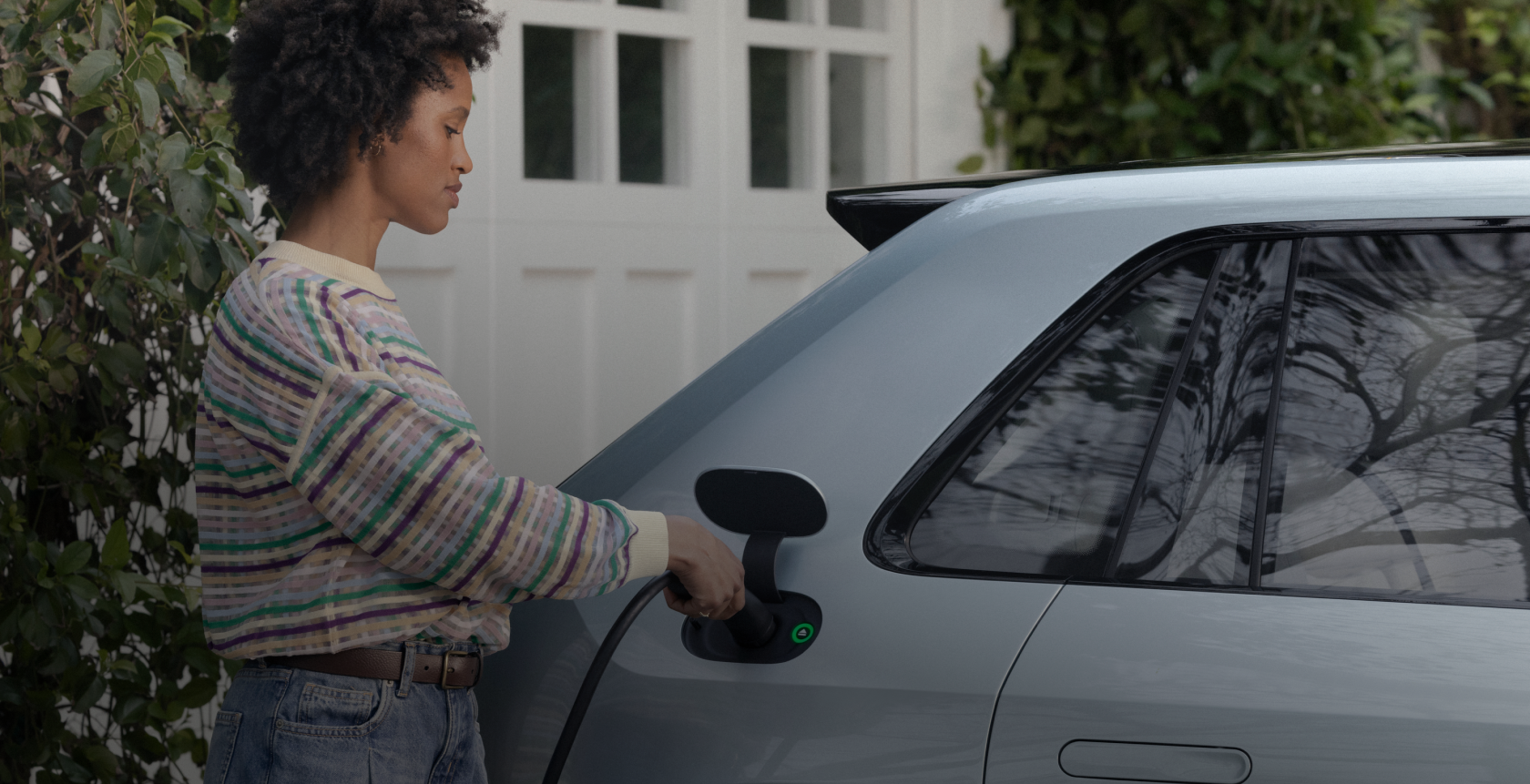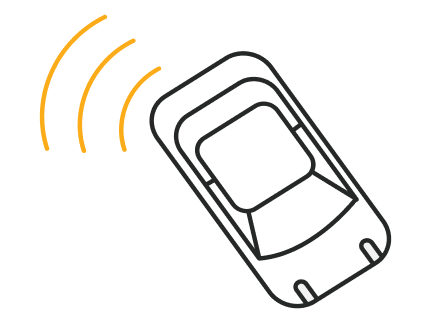Accelerating transportation:
EV innovation
Driving the future of mobility
Electric vehicles are changing what a car can do and how it is to own one. Advances in design, software and safety technology are allowing vehicles to update, learn and improve long after they’ve been built.

Understanding how EV technology works
The fundamental architecture of electric vehicles enables engineering and technological progress that isn’t possible within the mechanical limits of gasoline engines.
Electric motors convert about 90% of battery-stored energy into motion, compared to roughly 20% for gasoline engines. Because electric motors can deliver full power the moment you press the pedal, EVs only need a single gear. The result is smooth, uninterrupted acceleration without gear shifts or engine vibration. And with fewer moving parts overall, EVs also require less maintenance, which reduces operating costs.
In addition, many modern EV systems are managed by digital controls that coordinate everything from power delivery to safety features. Like a smartphone receiving software updates, many EVs can remotely download improvements that enhance performance, add features or strengthen safety — without visiting a service center.
An electric vehicle uses a straightforward drivetrain: energy from the battery flows through an inverter to one or more motors that turn the wheels. With few moving parts, this process is highly efficient, as over 90% of the electrical energy becomes motion.
Because power is generated through controlled electric current rather than combustion and heat, EV components experience less wear, which helps extend their lifespan and lower maintenance needs.
Electric motors deliver power instantly, responding the moment you press the pedal. In contrast, gas engines generate power gradually and need gears to stay within their ideal power range.
As electric motors operate efficiently across a wide range of speeds, they don’t require shifting and typically use only one gear. The result is steady acceleration and a quiet drive with no vibration or noise.
Every automotive manufacturer uses its own battery configuration. Most often, EV batteries consist of numerous individual cells, in some cases thousands, grouped into modules and then assembled into packs. These cells use chemical reactions to store electrical energy and release it on demand and their composition can vary depending on design priorities like cost or range.
The pack can reinforce the structure of the vehicle and is built to endure the hazards of everyday driving and beyond. Every piece of the battery, from individual cell components to the pack materials and assembly, are designed to support the safe operation of the vehicle.
Furthermore, the battery pack’s placement low in the vehicle’s chassis creates a low center of gravity. This dramatically enhances handling by distributing weight evenly across the vehicle, improving both driving performance and passenger safety, especially in winter conditions and during emergency maneuvers.
Understanding how EV technology works
The fundamental architecture of electric vehicles enables engineering and technological progress that isn’t possible within the mechanical limits of gasoline engines.
Electric motors convert about 90% of battery-stored energy into motion, compared to roughly 20% for gasoline engines. Because electric motors can deliver full power the moment you press the pedal, EVs only need a single gear. The result is smooth, uninterrupted acceleration without gear shifts or engine vibration. And with fewer moving parts overall, EVs also require less maintenance, which reduces operating costs.
In addition, many modern EV systems are managed by digital controls that coordinate everything from power delivery to safety features. Like a smartphone receiving software updates, many EVs can remotely download improvements that enhance performance, add features or strengthen safety — without visiting a service center.
An electric vehicle uses a straightforward drivetrain: energy from the battery flows through an inverter to one or more motors that turn the wheels. With few moving parts, this process is highly efficient, as over 90% of the electrical energy becomes motion.
Because power is generated through controlled electric current rather than combustion and heat, EV components experience less wear, which helps extend their lifespan and lower maintenance needs.
Electric motors deliver power instantly, responding the moment you press the pedal. In contrast, gas engines generate power gradually and need gears to stay within their ideal power range.
As electric motors operate efficiently across a wide range of speeds, they don’t require shifting and typically use only one gear. The result is steady acceleration and a quiet drive with no vibration or noise.
Every automotive manufacturer uses its own battery configuration. Most often, EV batteries consist of numerous individual cells, in some cases thousands, grouped into modules and then assembled into packs. These cells use chemical reactions to store electrical energy and release it on demand and their composition can vary depending on design priorities like cost or range.
The pack can reinforce the structure of the vehicle and is built to endure the hazards of everyday driving and beyond. Every piece of the battery, from individual cell components to the pack materials and assembly, are designed to support the safe operation of the vehicle.
Furthermore, the battery pack’s placement low in the vehicle’s chassis creates a low center of gravity. This dramatically enhances handling by distributing weight evenly across the vehicle, improving both driving performance and passenger safety, especially in winter conditions and during emergency maneuvers.
Expanding access to fast, convenient EV charging
Most U.S. drivers travel about 37 miles per day — well within the range of today’s EVs, which average about 270 miles per charge. That means, for the average driver, charging once a week is enough. That same range also allows for longer trips—such as Washington, D.C. to New York, Nashville to Atlanta, or Los Angeles to Las Vegas—without stopping to recharge.
For many owners, home charging is the simplest option: they plug in at night and wake up to a full battery. Public fast chargers play an equally important role, especially for long trips or for drivers who don’t have convenient charging in their building.
Today, about 64% of Americans live within two miles of a public charging station, with roughly 1,000 new chargers added each week nationwide.
Charging times for EVs vary based on several factors, including the vehicle’s battery size and the charging method. There are generally three different charging methods available:
- DC Fast Charging: High-powered public charging, frequently located near popular destinations and along highways. Delivers an 80% charge in as little as 20 minutes.
- Level 2 (240V AC): Common at homes, workplaces, shopping plazas and parking garages. Adds an 80% charge within 4-10 hours, typically while owners sleep, work or shop.
- Level 1 (120V AC): Uses a standard household outlet charging and adds a few miles of range per hour.
8 in 10 EV owners have access to home charging — either because it came with their home or they installed it themselves. For those without such convenience public charging networks are expanding quickly. Today, 64% of Americans live within 2 miles of a public charging station, and about 1,000 new chargers are added each week nationwide.
An EV charger sends electricity to the car through a cable that plugs into the vehicle’s charging port. Once connected, the charger and car exchange basic information—such as how full the battery is and how much power it can safely take. Charging automatically stops when the battery is full or if the system detects a problem.
Paying for charging depends on the network and vehicle. Many automakers have partnered with charging networks to enable plug-and-charge, where the charger instantly recognizes the car and begins charging, billing the driver automatically through a prelinked account. Other stations accept payment through apps, credit cards, or contactless methods, much like a regular gas pump.
Today, most EVs use either the North American Charging Standard (NACS) or the Combined Charging System (CCS). But since June 2023, all automakers selling EVs in the U.S. have announced they will adopt NACS and phase out CCS.
In other words, over the next few years, all new EVs sold in America will use the same plug: NACS, now also known as the official "SAE J3400" standard.
The U.S. has more than 200,000 public charging ports at over 75,000 locations nationwide. About 64% of Americans live within two miles of a public charging station and roughly 1,000 new chargers are added each week.
The federal goal is to reach 500,000 public chargers by 2030, with fast chargers placed roughly every 50 miles along major highways. EVs can locate nearby stations through built-in navigation systems or smartphone apps such as Google Maps, Waze, PlugShare or A Better Routeplanner, which automatically include charging stops when travelling long distances.
View Charging Station Locations
Driving the future with sustainable EV batteries
At the core of every electric vehicle is its battery, a system that stores and delivers the energy needed to move the car. Battery design and durability keep advancing fast: in 2010, the average EV could drive about 80 miles on a charge; today, leading models can go more than 400 miles. Most automakers now guarantee their batteries for eight years or up to 120,000 miles, with some offering longer coverage.
Gasoline is burned and gone after each trip. A battery, by contrast, keeps its materials (such as lithium and nickel) 100% intact. This creates a different kind of life cycle, where batteries can be repurposed to power new applications, or their materials recycled and returned to supply chains. Building such a closed-loop system within the U.S. keeps valuable resources in the country and minimizes environmental impact.
EV batteries are highly recyclable, containing valuable minerals like lithium and nickel that are not consumed during use, unlike gasoline. While large-scale recycling systems are still developing, key battery materials are already being recovered and returned to supply chains. As domestic recycling capabilities expand, they are becoming a central part of building a secure, circular battery supply chain.
Batteries can also be reused, for example, to stabilize the electric grid or provide backup power for factories and buildings.
Modern EV battery packs are engineered with multiple layers of protection to maximize safety in the event of a crash. Advanced battery management systems and robust, fully enclosed pack designs provide this critical shield.
Gasoline vehicles rarely catch fire — and several major studies confirm that EVs are even less likely to. All vehicles on American roads, regardless of how they’re powered, undergo extensive crash and safety testing to meet the same rigorous standards.
Temperature can influence EV range as extreme cold slows electrochemical reactions, while extreme heat activates cooling systems that consume energy. Modern EVs reduce these effects through advanced thermal management that keeps the battery within its ideal temperature range, and many allow preconditioning—warming or cooling the battery while the car is still plugged in—to further improve efficiency. This is typically done automatically through the vehicle’s app or dashboard settings.
Cold climates have proven not to be a barrier to EV use: Norway, Iceland and Sweden, known for their harsh winters, have the highest EV adoption rates in the world.
Redefining automotive performance with efficiency and power
Gasoline vehicles have long set the benchmark for power and versatility, yet modern EVs exceed industry norms in acceleration, torque and traction today. Even standard EV models can gain speed as quickly as gasoline sports cars, while others can tow heavy trailers or traverse rough terrain.
Electric vehicles introduce a new approach to automotive performance, differing fundamentally from gasoline engines. Because electric motors deliver instant torque through a single continuous gear, power is available the moment the driver presses the pedal. This direct power delivery also means EVs can maintain full torque even at low speeds, which is especially useful for towing or climbing steep grades.
In addition, the battery pack sits low in the chassis and this lowers the center of gravity and improves balance through turns. With a sealed underbody, electrical components are protected from water and debris, and many off-road EVs can confidently handle moderate water crossings as part of their design.
Regenerative braking lets an EV recover energy when slowing down. As the driver eases off the accelerator or applies the brakes, the electric motor runs in reverse, acting like a generator and sending electricity back to the battery. This process recaptures energy that would otherwise be lost as heat in traditional braking, which extends driving range and reduces brake wear.
Electric motors deliver their full power the moment they start turning. In an EV, this means torque (the force that makes a car move) is available immediately, without waiting for gears to shift or an engine to build speed.
EVs function similarly to a light switch: power flows instantly, without delay. This direct response makes them quick to move and predictable to control, for instance when merging onto highways or pulling heavy loads.
Most EVs carry their battery packs in the floor of the vehicle, which keeps the weight low and evenly distributed. This design pulls down the center of gravity, which reduces rollover risk and improves grip when cornering or braking. The result is a stable, planted feel on the road that helps the car stay steady through turns and balanced over uneven surfaces.
Keeping EVs up-to-date with over-the-air improvements
Over-the-air (OTA) updates allow vehicles to receive new software remotely, much like a smartphone. This technology turns cars from static products that leave the factory and never change into systems that can evolve over time. Typical OTA updates include added safety features, performance upgrades and new functionalities. Even technical issues can often be resolved remotely without a trip to the service center.
For drivers, OTA updates mean the car’s software can stay current with the latest advances in battery management, driver assistance and infotainment. Updates are delivered automatically without ever leaving the driveway.
Over-the-air updates encompass a wide range of enhancements — from improving the infotainment system and user interface, like updated navigation or new apps, to making critical adjustments that boost the vehicle’s real-world performance.
This means that a software update can increase range, enhance safety capabilities or improve acceleration overnight, without the need to visit a dealership or service center.
The user experience of OTA updates is almost identical to updates to your smartphone or computer. They typically occur in two stages: download and installation.
The software update file is usually downloaded automatically in the background while the vehicle is operational or parked, provided it has an adequate cellular or Wi-Fi connection. The installation process, however, generally requires the vehicle to be safely parked with sufficient battery charge. It may be scheduled automatically (e.g., overnight) or initiated manually by the driver via the infotainment screen when prompted.
Setting new safety standards in EVs through advanced technology
EVs are among the safest vehicles on the road, thanks to advanced technology, well-engineered rigidity and strict safety regulations. Many earn the highest safety ratings like TOP SAFETY PICK+ by the Insurance Institute for Highway Safety (IIHS). EVs’ low center of gravity, achieved through the strategic placement of battery packs along the vehicle’s floor, enhances stability, especially during sharp turns and emergency maneuvers. This design contributes to a more responsive and controlled driving experience than previously possible, while the robust battery enclosures strengthen the vehicle’s structural integrity, providing added protection in collisions.
In addition, modern EVs frequently feature advanced driver-assistance systems (ADAS) such as automatic emergency braking and lane-keeping assist. While ADAS are not exclusive to EVs, the inherent electric architecture, sophisticated onboard computing and precise electric powertrain contribute to making these advanced safety features more accessible in standard, mainstream vehicle configurations.
Advanced driver-assistance systems (ADAS) use sensors like cameras and radar to monitor a vehicle’s surroundings. They help drivers by providing warnings or automatically intervening in situations like potential collisions (automatic braking), drifting out of lanes (lane keeping), maintaining speed/distance (adaptive cruise control) or checking blind spots. ADAS significantly increase safety while making driving more enjoyable.
In the U.S., electric vehicles must meet the same Federal Motor Vehicle Safety Standards (FMVSS) that apply to gasoline vehicles, overseen by the National Highway Traffic Safety Administration (NHTSA). These rules cover crash protection, airbag performance, and overall structural safety to ensure occupant protection in all vehicle types.
Additional standards address EV-specific features, including battery safety during crashes, electrical isolation to prevent shock, and low-speed sound requirements so pedestrians can hear approaching vehicles. Together, these regulations ensure that EVs meet or exceed the same safety expectations long established for conventional vehicles.
EV batteries are designed with safety as the top priority. They are housed in robust, reinforced enclosures that are placed low and centered in the vehicle structure for maximum protection and stable driving dynamics.
In the event of a severe collision, automatic disconnect systems instantly isolate the high-voltage battery to prevent electric shock, while the robust enclosures are engineered to meet regulatory standards to minimize any potential leaks.
Advantages of simpler, cost-effective EV maintenance
One of the most practical aspects of EVs is how little maintenance they need. EVs have far fewer moving parts than gasoline cars, which eliminates the need for many standard services such as oil changes, spark plugs or timing belts. According to Consumer Reports, half of the ten most frequent maintenance items for safety and reliability do not exist in electric vehicles.
Brakes also last longer because regenerative braking uses the electric motor to slow the car, which reduces friction on brake pads. Tires, however, can wear about 15–20% faster due to the added weight and immediate torque of electric power, though regular rotation every 6,000 to 8,000 miles helps even out tread wear.
When all factors are considered, maintenance costs over 200,000 miles are half for EVs than for gasoline vehicles. Most manufacturers also back their batteries with warranties of around eight years or 120,000 miles, helping ensure reliability throughout the vehicle’s lifespan.
Electric vehicles have fewer moving parts than gasoline cars, which greatly reduces the number of regular maintenance items. The specific schedule varies by model, so owners should always follow their manufacturer’s recommendations.
EVs do not require many of the common service items found in traditional cars, including:
- Oil and oil filter changes
- Spark plug replacements
- Timing belt or chain replacements
- Fuel filter or exhaust system maintenance
- Transmission fluid changes (for multi-gear transmissions)
Much of an EV, however, is still like a traditional car, so some routine maintenance remains necessary:
- Tire rotation
- Brake fluid and cabin air filter replacements
- Battery coolant checks (for models with liquid-cooled battery systems)
- Suspension and steering system checks during scheduled service visits
Regenerative braking systems use the electric motor to help slow the vehicle, which means the brake pads are used less often. This reduces wear and makes the brakes last longer. At the same time, this mechanism delivers energy back to the battery to add range.
You have a few options, including authorized dealerships and service centers specializing in your brand, independent EV repair shops with certified technicians or mobile EV service providers. Maintenance covers routine checks and upkeep, while repairs address specific issues. Dealerships and specialized shops handle both, but basic maintenance can be performed at general auto shops familiar with EVs.





































